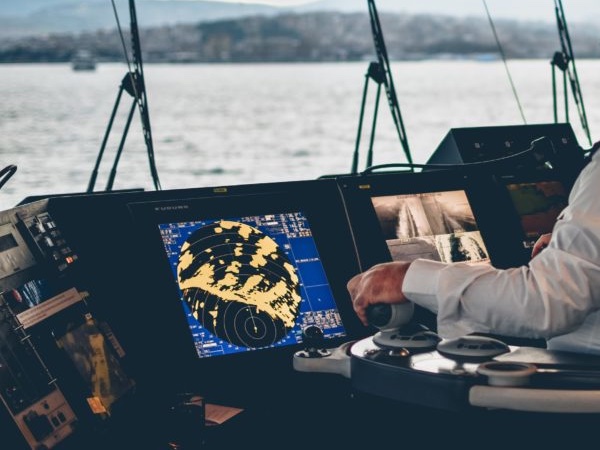Though marine radars are indispensable equipment on the bridge, it still has their own limitations. Knowing this allows the Officer on Watch to make the best decision.
The main limitations of marine radars are range, bearing, and accuracy. Other minor factors include target acquisition, pulse length, wavelength, and sensitivity.
Radars are an effective tool onboard for collision avoidance and close-quarter situations. Knowing the functions and limitations of such increases the confidence of an OOW and allows them to adapt accordingly.

Functions and Limitations of Marine Radars
A merchant marine vessel can have two or three marine radars. These are the primary equipment being relied on by officers for safe and efficient navigation. The main radar is designated and a backup radar is assigned to alternate usage and minimize wear and tear on major parts.
One major limitation of radar is range. Marine Radar works either on S-band(3 GHz) or X-band(10 GHz) frequencies. They are also known as 3cm radar or 10cm radar called so by the wavelength. Knowing when to use which equipment will aid officers and pilots in an effective ship operation.
The S-band marine radar is designed for long-range detection. Though the maximum range is only forty nautical miles. This type of radar is also preferred during heavy weather especially rain/fog and zero visibility. The greater the height of the scanner above sea level, the greater the detection range.
The X-band marine radar on the other hand is more effective for shorter ranges. This is particularly useful during channeling, anchoring, berthing, and undocking maneuver. It works on higher frequencies, thereby having a sharper image and better resolution.
Other factors that affect the range of radars are the height of the scanner, power of transmission, wavelength, pulse repetition frequency, pulse length, vertical beam width, horizontal beam width, receiver sensitivity, nature of the target, weather, propagation, and heavy swell.
The next major limitation of marine radar is the accuracy of bearing. Bearing is the determination of the direction of targets. The true bearing of a radar target is the angle between the true north and the line pointed directly at the target. This is measured in a clockwise direction.
As per IMO performance standards for navigational RADAR, the bearing of a target or an object whose echo appears on the edge of the display should be capable of being monitored or measured with an accuracy equal to or better than one degree.
Other factors that affect the bearing accuracy are the correct alignment between the heading marker and scanner as well as the heading marker and the bearing scale. Gyro error, rectilinearity of the trace, beam width distortion, and scale size of the spot also impact the bearing accuracy of the radar.
Lastly, the accuracy of the performance of the radar itself has a limitation. As constructed and installed on the bridge, radars are integrated into other equipment like ECDIS, GPS, AIS, gyro steering, speed log, echo sounder, and NavTex, including weather instrument readings.
Minor Limitations of Marine Radar
A minor limitation of radar includes target acquisition. Target acquisition allows the ship to have a digital read-out of ships in the vicinity which provides critical information like course, speed, ranger, bearing, closest point of approach, and time to CPA.
Radars can either manually or automatically acquire targets. The latest technology Fast Target Tracking™ presented by Furuno allows fast target acquisition in just a few seconds predict the target’s trajectory.
However, ARPA Radars has a limit of 20 targets for automatic acquisition and 40 targets for manual acquisition. This number will also be lessened as the vessel experiences heavy rolling and pitching.
Pulse length is another minor limitation of radars onboard. The radar pulse length can either be a short pulse or a long pulse. Short pulse has better range resolution and lesser sensitivity. It allows closer targets to be plotted as distinct ones. Long pulses have lesser range resolution but better sensitivity.
Long pulses require more power and have the ability to experience more attenuation in the atmosphere ensuring better maximum range in comparison to short pulses.
Wavelength also affects the operation of radars. These radars operate in either a three-centimeter wavelength or a ten-centimeter wavelength. Three cm wavelength provides a better and more detailed picture in the display compared to those transmitting on a ten cm wavelength.
10 cm radar also provides greater range coverage while 3 cm wavelength radar is more effective in the early detection of targets and objects at ranges greater than twenty nautical miles.
The sensitivity of radars can also have some limitations. In layman’s terms, the sensitivity of radar is how thick a particular radar plots the target. A good sensitivity means a radar can display even a small fishing boat as a slightly bigger target. With less sensitivity, on the other hand, it’s likely that smaller objects cannot be displayed on the screen.
There are ways to compensate for the sensitivity of radar. Officers can make use of the gain setting, rain/sea clutter, and interference rejection. Gain can be used to increase the receiving sensitivity of radar. It needs to be adjusted up to a level where targets are clearly visible on the screen but with no other interference.
Rain clutter is used to reduce and minimize the clutter echo caused by rain while sea clutter is used to reduce clutter caused due to surface of the sea.
- Types of Gas Carriers as per IGC Code – April 22, 2025
- Wind-Assisted Propulsion Systems (WAPS): A Game Changer for Maritime Decarbonization – February 6, 2025
- 10 Boat Salvage Yards in California – January 25, 2025



